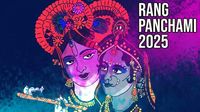Rang Panchami 2025: This year, the festival celebrated on March 19 marks the joyful conclusion of Holi festivities with vibrant colors and deep traditions.
Rang Panchami, also known as Krishna Panchami in certain regions, is a lively festival observed primarily in Maharashtra, Gujarat, Madhya Pradesh, and parts of Rajasthan. This year, the auspicious occasion falls on March 19, 2025.
According to Drik Panchang, the Panchami Tithi begins on March 18 at 10:09 PM and concludes at 12:36 AM on March 19.
The significance of Rang Panchami can be traced back to its cultural and religious roots. Unlike the main Holi celebrations filled with both dry and wet colors, Rang Panchami closely associates with the divine play of colors related to Lord Krishna and Radha. It's believed that celebrating with colors on this day helps to dispel negative energies and invites positive spiritual vibrations.
In some areas, the festival is referred to as Krishna Panchami or Dev Panchami. Particularly in Mathura and Vrindavan, where Holi festivities often last longer, Rang Panchami represents a grand finale with vibrant temple events, including Rangotsava (color festivals) and spiritual processions.
Rang Panchami is celebrated with enthusiastic color play. Devotees joyously throw Gulal in reverence to Lord Krishna, echoing his playful spirit during Holi with Radha and the Gopis. Special pujas and cultural events are commonplace during this festival, with prominent exhibitions seen in Krishna temples located in Mathura, Vrindavan, and Ujjain where grand processions and artistic tableaux are staged.
The involvement of municipalities in cities like Ujjain enhances the celebrations, as they orchestrate large Holi processions featuring municipal vehicles spraying fragrant colors through massive pipes that turn streets into vibrant spectacles.
The festival established five days after Holi is not merely about the spirit of play; it holds a deeper meaning and reflects the triumph over negativity, honoring the five elements of nature: fire, earth, water, air, and space. This joyous day encapsulates the essence of community spirit and divine blessings.
The narrative background of Rang Panchami also adds a dimension to its cultural importance. According to Hindu mythology, the tale revolves around Lord Shiva and Kamadeva, the god of love. In an attempt to rouse the meditating Lord Shiva, Kamadeva shot his flowered arrows, angering Shiva, who retaliated by incinerating Kamadeva in ashes. Moved by devotion, Kamadeva's wife Rati, along with other deities, implored for his revival. Impressed by their faith, Shiva restored Kamadeva, yet only in a spiritual form. This divine celebration of restoration is believed to be the origin of Rang Panchami, epitomizing the victory of divine energy over negativity.
As March 19 approaches, devotees across regions are preparing to embrace the colorful tradition. Special wishes and messages have surfaced to encourage families and friends to engage in celebration, reminding them to let joy and love fill the colors of their lives.
Rang Panchami, therefore, is not just about sprinkling colors; it symbolizes a deeper spiritual reality, invoking positive energies and acknowledging divine blessings.
Indeed, as the festival unfolds this year on March 19, let the colors of joy, love, and laughter brighten each participant's day.





